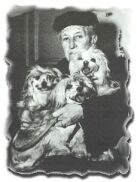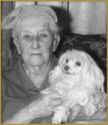|
Early Breeders.
The earliest mentioned breeder is of the 19th
century. Dr. Walthier, of Germany. He explained that the breed was called
Leoninus merely because of the trim, not by possessing a fierce lion-like
personality. The next breeder we know of actually played a part in the
Löwchens resurrection. Breeding and exhibiting Löwchen at the turn of the
century, as the breed was making what seemed its final bow, was Maximillian
Coninck from Belgium.
The most important client he had came to him in 1897. She was Madame Bennert,
then a young married woman, acquiring her first Löwchen. This was the start
of a lifetime love affair between Madame Bennert and her pride of lions.
A little known person also emerges as having a hand in the resurrection of
the Löwchen. Herr Professor Kurt Konig, from the Zootechnisches Rotenburg in
Germany began gathering Löwchen at the turn of the century for genetic
research. He called the dogs gathered into his breeding program
Kobaldt-Mascotts and Kobaldt-Daumlinge. He and his research associates
gathered dogs that were extremely hardy, healthy and outgoing. He did not
tolerate shy dogs. After they gathered the dogs best suited for the program,
they closed their breeding programs to dogs from outside. It was not until
he was elderly and made contact with Madame Bennert, that his dogs
contributed to the gene pool of today's dogs. Madam Bennert and Professor
Konig determined that their dogs stemmed to common ancestors and so they
would be of use to both breeding programs.
On December 6th, 1957, a black and white bitch named Quinte was transferred
to Madame Bennert, and registered by her with the ALSH registry as Fgitane,
on June 11th, 1958. Fgitane was bred to Blaguer and on September 27th, 1958
she produced the litter that Judith came from. Whether Madame Bennert sent
dogs to professor Konig is unknown. Sadly Fgitane was the only dog from his
program to be incorporated into Madame Bennerts breeding program. What
became of his dogs is unknown.
Madame
Bennert Steps Forward.
 In Brussels, 1896, Madam Bennert was a young
married woman. Looking for the ideal family pet, she discovered the Lowchen.
She bought her first Löwchen from Maximillian de Coninck in 1987. While she
had no intention of becoming a breeder, she was keenly interested in the
breed. It was not until World War 11, that she realized she would have to
step forward to save the breed. By the end of the dark days of World War 11,
breed registries had become disorganized and disappeared. Madam Bennert
realized that there was no one breeding or registering Löwchen any longer.
Her fear was that the breed would disappear into the mists of time as so
many other breeds did during that period, and as had done during World War
1. She resolved to save the Löwchen and began research to find quality
specimens of the breed. In her words: "After a long and
disappointing search I finally found two wonderful females; one was blue and
came from (the town of) Lille, and the other was biscuit colored and came
from the area of Dieghem. After a long search I finally found a blue male
and this was the beginning of the breed's second chance." In Brussels, 1896, Madam Bennert was a young
married woman. Looking for the ideal family pet, she discovered the Lowchen.
She bought her first Löwchen from Maximillian de Coninck in 1987. While she
had no intention of becoming a breeder, she was keenly interested in the
breed. It was not until World War 11, that she realized she would have to
step forward to save the breed. By the end of the dark days of World War 11,
breed registries had become disorganized and disappeared. Madam Bennert
realized that there was no one breeding or registering Löwchen any longer.
Her fear was that the breed would disappear into the mists of time as so
many other breeds did during that period, and as had done during World War
1. She resolved to save the Löwchen and began research to find quality
specimens of the breed. In her words: "After a long and
disappointing search I finally found two wonderful females; one was blue and
came from (the town of) Lille, and the other was biscuit colored and came
from the area of Dieghem. After a long search I finally found a blue male
and this was the beginning of the breed's second chance."
The first three Löwchen registered and used for breeding were
Ulan, born in 1946, Sirginia who was born in 1944, and Z'Marquise whose
birth date is unknown but was registered in 1949. Madame Bennert bred Ulan
and Sirgrina. Her first litter was born April 13th, 1948. Madame Bennert
kept Xandre, a male out of the litter, and her breeding program was
underway.
|
|
Through the years Madame Bennert traveled far and wide to publicize the
breed. Her travels took her to Germany where, when searching for a hunting
dog for her nephew, she met Dr. Rickert.
 Dr. Rickert was a veterinarian who had a special interest in genetics. Madam
Bennert asked him to advise her with her breeding program, which he agreed
to do so. He and his wife became close friends with Madam Bennert. They
traveled back and forth between Belgium and Germany. Their visits were
consumed with discussion of the breeding program to save the breed. As
Madame Bennert aged she began asking Dr. Rickert to take over the breeding
program, but he did not really have an interest in breeding the small dogs.
But, as Madam Bennert became more infirm with age, he was struck with the
realization that if he did not begin to take over, Madam Bennert's work
would be for nothing! Dr. Rickert was a veterinarian who had a special interest in genetics. Madam
Bennert asked him to advise her with her breeding program, which he agreed
to do so. He and his wife became close friends with Madam Bennert. They
traveled back and forth between Belgium and Germany. Their visits were
consumed with discussion of the breeding program to save the breed. As
Madame Bennert aged she began asking Dr. Rickert to take over the breeding
program, but he did not really have an interest in breeding the small dogs.
But, as Madam Bennert became more infirm with age, he was struck with the
realization that if he did not begin to take over, Madam Bennert's work
would be for nothing!
:: Page
1 :: Page
2 :: Page
3 ::
|